Every two years as October sweeps the Ohio River Valley with hues of yellows, reds, oranges and browns, the Cincinnati Art Museum springs to life with a vibrant array of floral arrangements in conjunction with a variety of works from its permanent collection. Since 2001, Art in Bloom has been inviting virtuosic, imaginative floral designers and arrangers to participate in their biannual event depicting the “marriage of floral interpretation and fine art.â€
The intricately balanced floral composition for The Sacred Hour is a superb example of this union. The intensity of the blue delphinium, the red berries and carnations, and the varying shades of green of the fugi mums, kale and thistle traverses effortlessly from the canvas to the pedestal. The ruscus leaves rhythmically intertwine the white lattice (intimating the painting’s frame) anchored in an oval vase that harmonizes with the blue fabric of the women’s dresses.
The sacred moment for the viewer is a miniature garden of earthly delight. And in the hands of such a skilled matchmaker, this “marriage of floral interpretation and fine art†has been elegantly consummated.Â
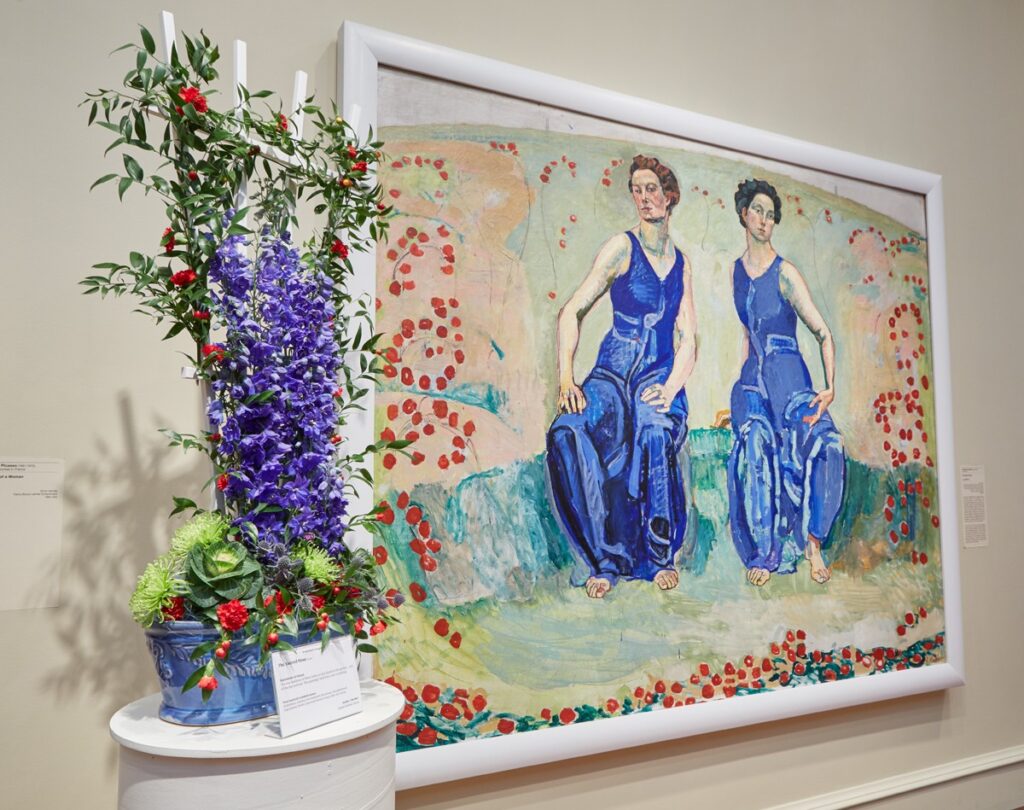
Now, for a point of total contrast, let us contemplate this 1880s bed and its connubial floral representation. The plastic arts (functional or otherwise) were also included on the roster of museum pieces from which the participants could choose, but the interpretation of three-dimensional works in a floral arrangement presents a special challenge because of the particular attention that must be given to form.
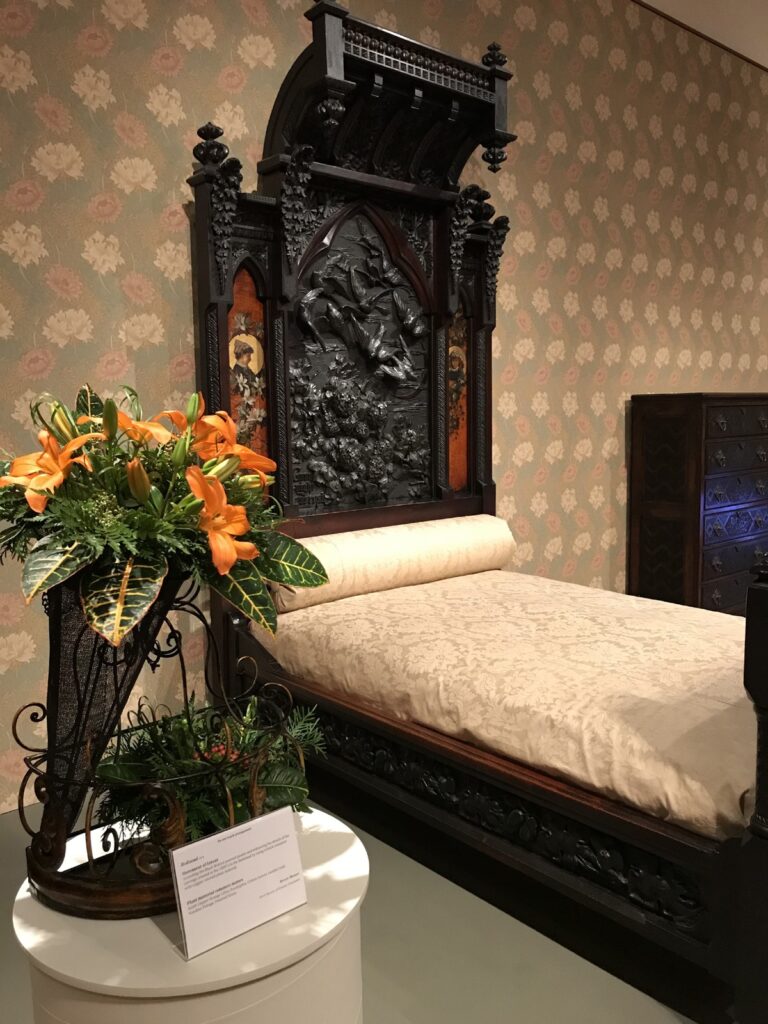
Bedstead demonstrates jaw-dropping ingenuity in this regard. The metal container on which the tightly-clustered, copper-colored arrangement rests with a black gauze-like fabric draped over it and falling to each side strongly suggests the arches, the carvings, and the panels in the headboard. What impressed me most is that the arranger lightened the weightiness of the bed by softening the bedding of the container with a looser spread of foliage. A challenge well met.
Simpler, effective, yet no less challenging is Arch, acrylic with fabric dyes on canvas. Form is obviously tantamount for a successful matrimony between these two pieces but, as with any marriage, it takes more than one thing to make it work.Â
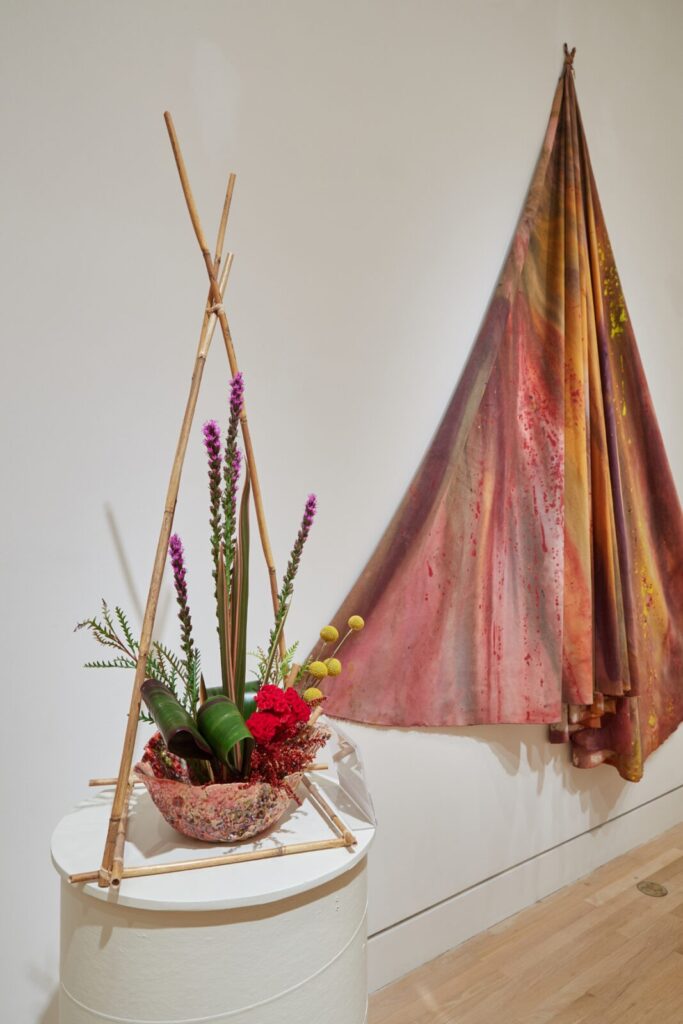
First, there is the tent-like structure emulated by the openly framed bamboo pyramid that encases the flowers. Then the tinted colors of the fabric are deftly repeated in a small bowl that replicates the texture and the visual feel of the cloth it represents. Finally, the fairly sparse and spacious arrangement, if you take a closer look, is an inversion of the shape hanging on the wall. This unique interpretation demonstrates a counterpoised blend of conscious thought and intuition that go beyond the obvious.
Many of the designers (70 in this year’s event) tended to migrate toward the museum’s traditional European collection for their inspiration such as The Liberation of St. Peter. This Ikebana presentation was perfect for articulating the mannerist style of the painting and the dramatic single source of light that emphasizes line and motion of the two figures. And in this instance, the subject matter is equally important.
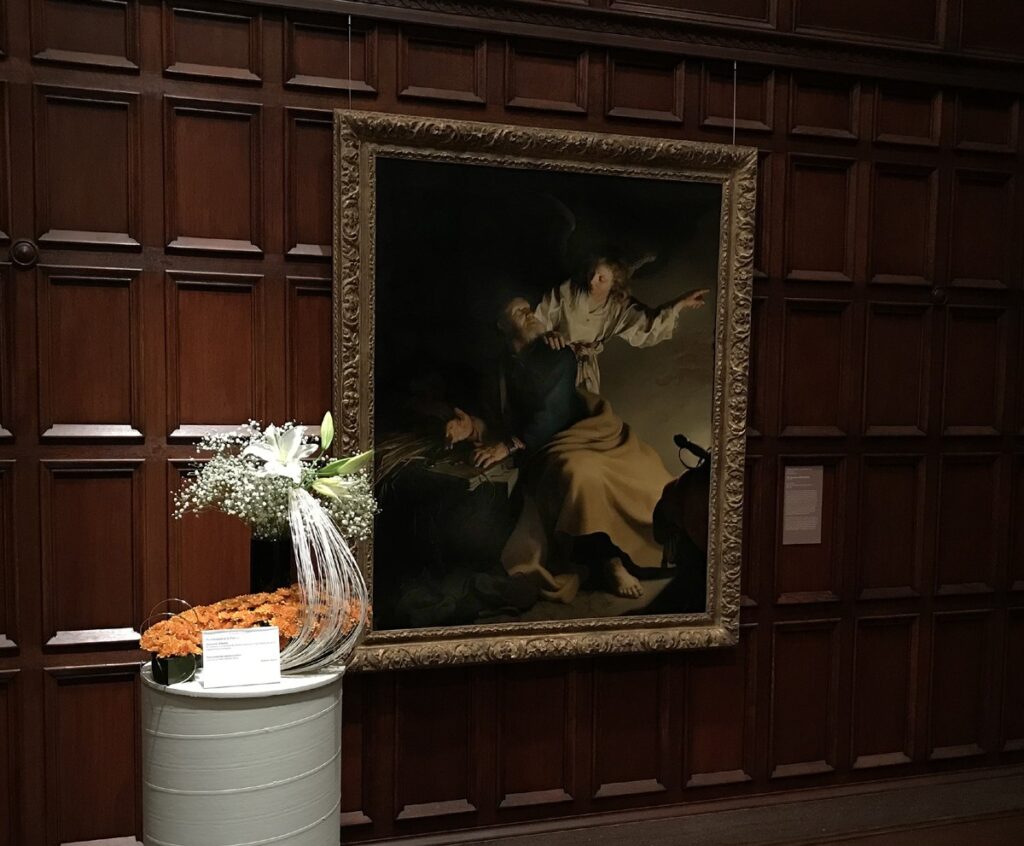
When I spoke with floral designer Koukichi Uchiyama, he explained that for him there was only one way to communicate both the visual and narrative aspect of the painting—through abstract expression. The lilies and the baby’s breath represent the angel and her ethereal nature with one of the buds actually pointing in the direction of the angel’s finger. The s-curved mums, on the other hand, represent St. Peter’s earthbound imprisonment in cuffs and chains further symbolized by the three steel rings placed in the mums. Uchiyama commented that the foremost ring, which has fallen forward, is indicative of St. Peter’s ultimate deliverance. And his use of s-curved strips of mizuhiki rice paper masterfully bridges the gap between the physical and celestial worlds. The result is a fascinating Eastern take on a Western work of art.
Always popular with museum goers are the romantic/impressionist landscapes and seascapes sacrosanct to any sizable permanent collection. And two interpretations in particular caught my eye for very different reasons.Â
The presentation for Valley Marsh is a suggestion and a statement arranged via simple and calculated placement of pepper bush and pepper grass, lily and lily grass, goldenrod and aster—plants that could be indigenous to the blustery, windswept marsh portrayed in the painting.
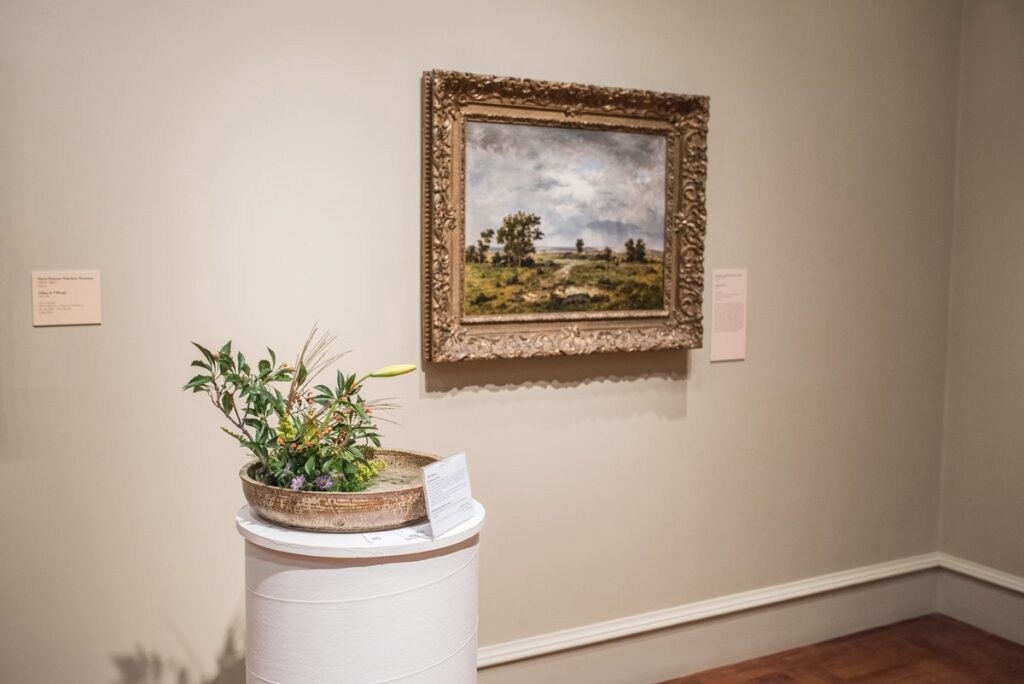
The arrangement manifests as an interpolation, an extraction of the landscape we see beside it. It is also an interjection because it only partially occupies the basin in which it sits. The basin, too, is a strong unifying component because its color and texture direct the eye to the frame of the painting and visible patches of earth within. The fact that the arrangement is placed off center and to the left makes the basin look a bit like a fountain begging for water much like the landscape to which it belongs.
In a slightly different vein, one of the goals of the impressionist school is to capture the “fleeting moment†and so is the intent of the beautifully integrated flowers and foliage in the spray that interprets Sunset, Vevey, Switzerland. Accentuated with roses, it offers up “soft pastels, warm apricot and taupe against a charcoal gray shoreline allowing viewers to be immersed in a specific moment in time.â€Â But it goes beyond even that.
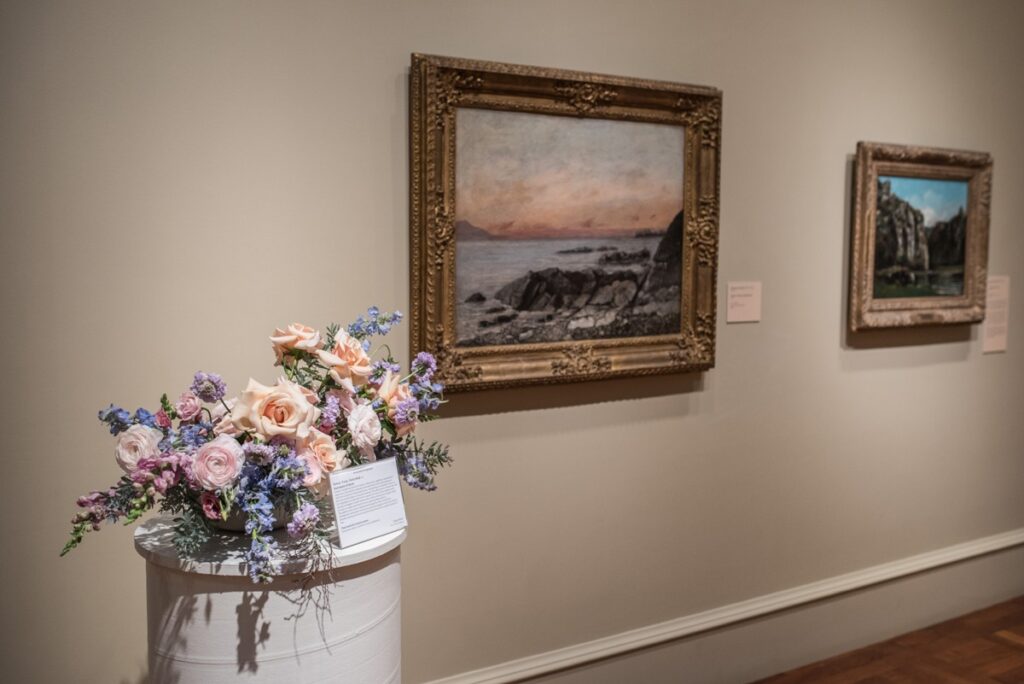
The elements of this display (space, color, texture, and design) are so thoroughly aligned with the elements of the scene it depicts that it could easily be lifted from the pedestal, plopped into the painting and be totally absorbed—to the farthest reach of the imagination, molecularly conjoined—the two become one.
Far from conjecture, some of the more literal interpretations interspersed throughout the museum seem to take a greater degree of risk. For an arranger to include an object that is actually in a painting seemed to me a little like fudging but how well this strategy works depends on how well the object translates from the painting to the arrangement and the arranger’s intent.
Without actually including the object in the astounding arrangement, Vanity Case, the designers instead literally interpret the essence of a peacock etched on the front of the object itself.
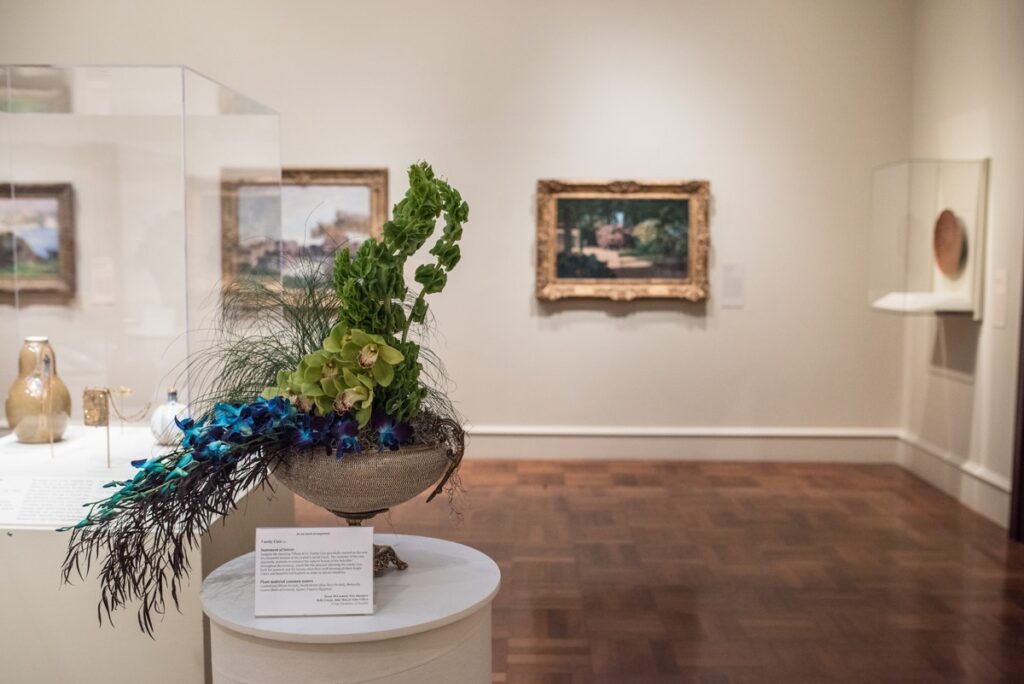
This small, exquisite Tiffany vanity case sitting under protective glass to the left of the arrangement enabled flocks of viewers to examine it before they walked around the peacock in a curious state of disbelief. Because feathers are not permitted in any of the floral designs, the team had to rely solely on nature and a remarkable vase to conjure up the likeness of this fantastic bird. Their use of White Orchids, Blue Born Orchids, and Bells of Ireland combined with Agonis and Egyptian Papyrus allowed them to create what is, in its own right, a work of fine art, albeit an impermanent one.
I would be remiss to not comment on at least one interpretation of an abstract painting and Romanian Blouse seems to fit the bill. While some entrants for Art in Bloom may steer clear of abstract art for fear of not understanding it or misinterpreting its meaning (if it has one), others are drawn to it because of the latitude it provides for full and open expression in relation to the basic elements of art and design associated with it.
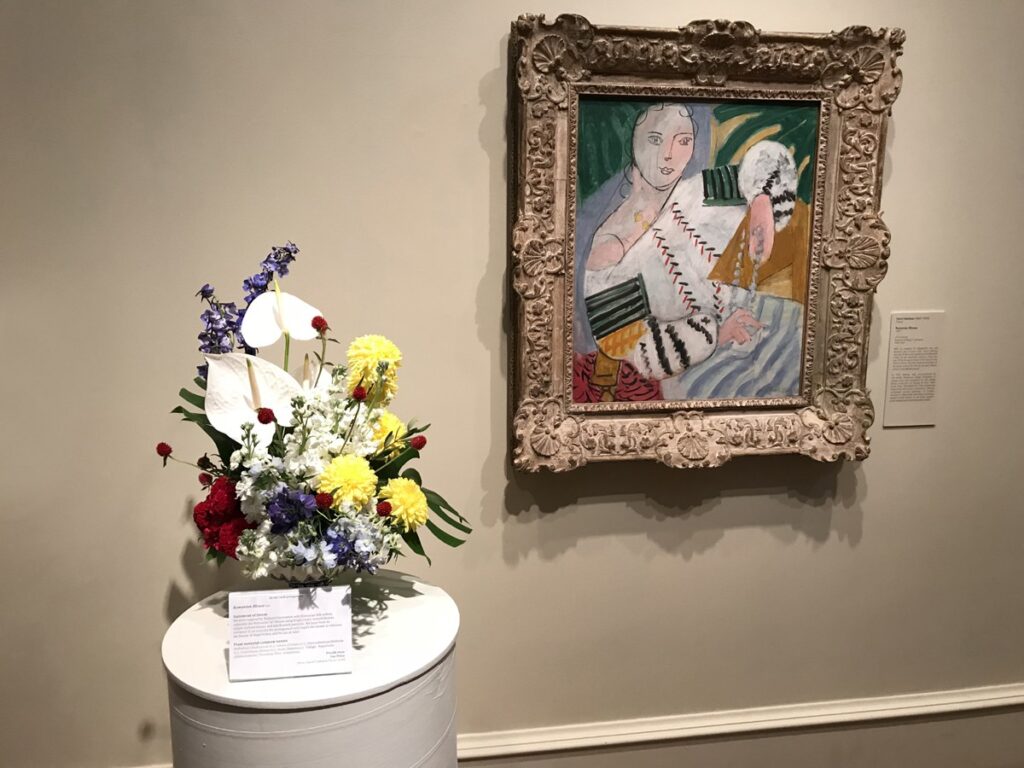
Lines, shapes, patterns, positive and negative space, and blotches of color have an equal impact on this interpretive arrangement for Romanian Blouse. Although some of the colors have been substituted, such as yellow for gold and lavender for gray, others such as the whites, reds and greens make the necessary connections for us. The overall movement and feel of the painting is well conveyed—cheerful and contemplative. Sometimes it is enough for us to say, “It works!â€
Because “the marriage of floral interpretation and fine art†is at the heart of Art in Bloom, it is impossible to not become engaged when you see one of these exhibits. Interpretation is catching. For starters, you have the arrangers interpreting the artwork and then you yourself reactively interpret the interpretation in front of you based on how well you think it executes the ideas expressed in the arrangers’ statements of intent and the plant material they chose to use. You also get to cast a vote for the top three on your list in order of preference, the same manner in which the arrangers get to select the work of art they interpret.
During the Art in Bloom four-day event, the museum invites two or three artists to come in each day and set up their easels and paint their interpretation of the arrangements, fostering a cycle of creativity and interaction with the artwork and floral designs for the duration of the exhibit.
So keep in mind that you as a visitor in October 2019 can also become a part of this cycle and be united with the wonderful world of fine art and its marriage to floral interpretation. And admission for the last three days of the exhibit is always free.
All images provided by the Cincinnati Art Museum.




